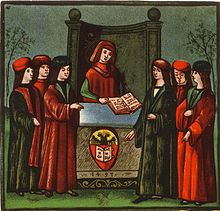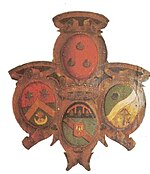Nationes
The Nationes were territorially structured corporations of students and lecturers who were formed at early European universities and from which the student liaison system of the 19th century developed in the German-speaking area . At the Council of Constance (1414–1418), the nationes were also a category of geographical classification and an organizational pattern (→ Council nation ).
The main function of the nations of the academic corporation, which were initially founded as protective associations by professors and scholars , mainly abroad, was basically divided into two parts. On the one hand, a nation was a legal and social community that sought to protect the interests and privileges of its members and enable them to make a living; on the other hand, she took on organizational tasks (matriculation), helping to shape management bodies and administrative work.
General
Nationes existed in the early high schools in Ravenna, Bologna, Salerno and Padua, but they were also common a little later in Paris, Oxford and Cambridge. As a rule, they did not have a brotherhood in character ; but each of the scholars had to be a member and pay dues.
Schindelmeiser writes: “In the historical account of German fraternity students, the national colleges are brought under the umbrella term 'Landsmannschaften'. They can be found in the Protestant universities since the Reformation and are referred to as the "old country teams" until the end of the 18th century. Documentary documents are generally only from the period after 1600. ”In the“ book ”of Westfalia zu Rostock (1623), for example, there are provisions on admission, the election of the senior and the cash management. The voting of the younger members is not binding for the older ones. The newcomers have to wait for the older ones at the national feasts. They are not allowed to wear coats, rapiers and bows for luxury. In the statutes of the Brandenburg citizens there (1633), the new arriving compatriots are recommended to join the older ones without delay so that “they do not become the prey of strangers”. They should immediately give their names to the nation in order "to participate in the protection and advice of the Landsmannschaft". The purpose of the connections is stated: "mutual friendship inward, firm cohesion outwardly and faithful maintenance of local customs". Elsewhere it says: "Everyone should practice the virtues that belong to a student, but especially to a fellow countryman: respectability, modesty, calm."
Distinction
The nations of the northern type are distinguished from those of the southern type. While the northern nations were authoritarian led by masters and from the 12th century other types of corporations emerged, the somewhat older southern-type nations were to remain for centuries. So in the north, at the Paris University " Sorbonne ", the " Bursen " as well as at the universities in Oxford , Cambridge and probably also at the Sorbonne, the colleges , also known as colleges , which later replaced the nations.
Members of the university joined the nation that most closely matched their origins. Students and professors spoke Latin .
Southern type: Modus Bononiensis

The southern Nationes first emerged with the establishment of the University of Bologna (probably 1088). It was called universitas magistrorum et scholarium early on and the students were given the right to vote in the election of rectors and were thus able to strongly influence professors and the university apparatus, in contrast to the northern nation.
The whole (universitas) of the professors and students of a university was divided into seventeen nations. Here the nationes were again divided into the 'this world' (citramontanorum) , that is, the three nations Italians, and the 'otherworldly' (ultramontanorum) , fourteen nations from the other regions. Here, for example, there was a "German" nation that played an important role well into the 17th and 18th centuries.
Northern type: Four Nations Model
The four-nation model of the Alma Mater in Paris had a territorial classification of the country teams according to the four cardinal points and already showed the faculty principle . Thus at the University of Paris there was the English nation for the northern and eastern Europeans, plus the Norman, Picardy and Gallic nations. The scholars from German-speaking regions were combined with the “English” and Northern Europeans to form the “natio anglicana”.
This model has been established across Europe since the middle of the 13th century.
Foundation of German universities
When it was first founded on German territory in 1348 in Prague , the nation also entered the Holy Roman Empire . At the end of the Middle Ages, Charles University in Prague was regionally divided into a Bohemian (which included Czech and German-speaking scholars), a Bavarian, a Saxon and a Polish nation.
Nationes also had their own patron saints: Emperor Charles V , for example, allowed the two heads of the German nation to appoint notaries, to carry weapons and to legitimize illegitimate children.
In Leipzig ( University of Leipzig , founded in 1409) there were the Meissen, Saxon, Bavarian and Polish nations, while in Vienna ( University of Vienna , founded in 1365) there were the Austrian, Rhenish, Hungarian and Saxon nations. In Königsberg ( University of Königsberg , founded in 1544) there were the Pomeranians, Silesians, Prussia and Westphalia in 1670.
- Badge of the country teams at the University of Leipzig
Admission rituals
A newcomer was required to take an oath that firmly bound him to the nation. The Deposition (university) | Admission rite was first adopted as an unofficial act by Paris. The newcomer (Bejan, Fuchs , Voss) had to abandon his “stupid behavior”, “reject” in order to become a real student. The “ fox ” had to endure painful physical and mental treatments, and he had to “pay” a deposit fee and a deposition feast. The nations showed the first signs of self-government and developed their own costume. Later, the deposition (university) became an official act of acceptance.
Sometimes the scholars were forbidden to speak in their native language.
resolution
The more consistently the faculty system with its four directions, artes , jurisprudence , medicine and theology asserted itself , the more obsolete the creative participation of the nation became.
- The nationalization process of the early modern period, in which the autonomous universities came under the statistic trustee , led to a “professionalization” of the academic staff and to a reduction in participation.
- In the German Empire there were around 45 universities in the 18th century , which led to a regionalization of the universities and a decline in peregrinatio academica and internationality.
- By the middle of the 17th century, the number of students had dropped to about 5,000. In addition to the increased number of universities, this is due to the ongoing wars of this time.
- The denominational ties of the respective territories and their universities. In the reformatory process, bursa and colleges were dissolved and the importance of nations in the union of students of the same denomination was lost.
Nations existed as a formality at Leipzig University until 1830. So Johann Wolfgang von Goethe still had to enroll in the Bavarian nation .
Today's coverage: student nation
Even today, at universities in Sweden (especially in Lund and Uppsala ), Finland and Estonia, the organizational form of the nation with similar tasks lives on .
literature
- Sabine Schumann: The “nationes” at the universities of Prague, Leipzig a. Vienna. A contribution to older university history , Diss. Phil. Berlin 1974.
- Siegfried Hoyer : The scholastic university until 1480. In: Alma Mater Lipsensis. History of the Karl Marx University Leipzig. Leipzig 1984.
Web links
Individual evidence
- ^ Rainer A. Müller: Landsmannschaften and student orders at German universities of the 17th and 18th centuries from: Historia academica, Volume 36, Würzburg, 1997, p. 15f.
- ^ Siegfried Schindelmeiser: The Albertina and its students 1544 to WS 1850/51 and the history of the Corps Baltia II zu Königsberg i. Pr. (1970-1985). For the first time complete, illustrated and commented new edition in two volumes with an appendix, two registers and a foreword by Franz-Friedrich Prinz von Preussen, edited by Rüdiger Döhler and Georg von Klitzing, Munich 2010, ISBN 978-3-00-028704-6 , Vol. 1, p. 35.
- ^ W. Fabricius : The German Corps . Frankfurt am Main 1926, p. 17 ff.
- ↑ Th.Ellwein: The German University - From the Middle Ages to the Present. 1985, pp. 305-307.
- ↑ Compare: I. Matschinegg: Education and Mobility. Viennese students at Italian universities in the early modern period. In: K. Mühlberger / Th. Maisel: Aspects of educational and university history from the 16th to 19th centuries. P. 307ff.





